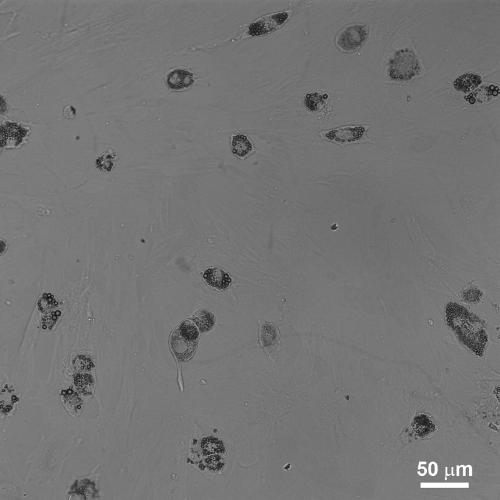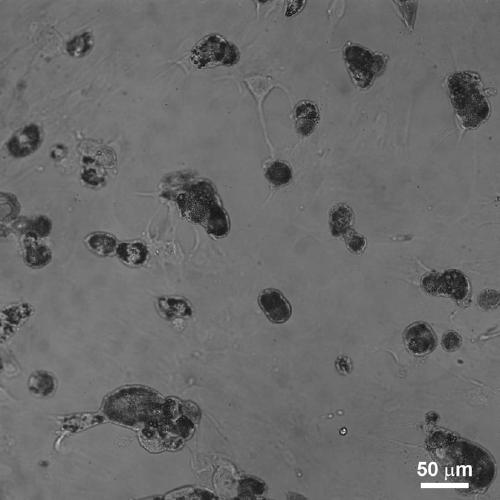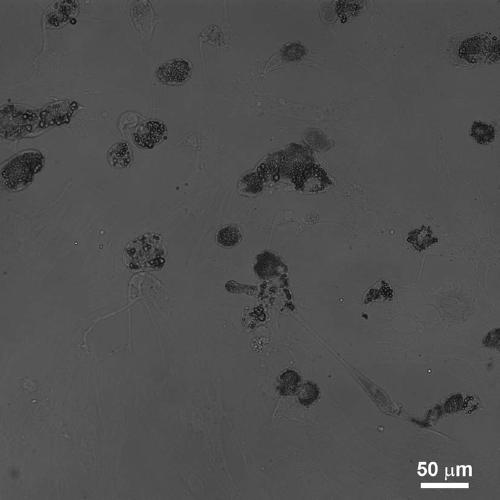A method for improving the adipogenic differentiation efficiency of bone marrow mesenchymal stem cells
A bone marrow mesenchymal and adipogenic differentiation technology, applied in the field of stem cell differentiation and biomedicine, can solve problems such as low efficiency of adipogenic differentiation, achieve high repeatability, meet clinical application requirements, and have no cytotoxic effects.
- Summary
- Abstract
- Description
- Claims
- Application Information
AI Technical Summary
Problems solved by technology
Method used
Image
Examples
Embodiment 1
[0026] Rat bone marrow mesenchymal stem cells were selected as the cell model, and MSCs were extracted from the bone marrow cavity of tibia and femur of newborn SD rats by whole bone marrow adherent method and cultured. The culture medium of MSC was low-sugar DMEM medium containing 10% (volume ratio) fetal bovine serum (FBS), 100 U / mL penicillin, 100 μg / mL streptomycin and 2 mM L-glutamine. After MSC extraction, store at 37 °C, 5% CO 2 The primary culture was carried out in an incubator, and the new culture medium was replaced every 2 to 3 days until the MSCs basically covered the bottom of the culture bottle, and then subcultured. The passage time does not need to be too early.
[0027] When performing cell subculture, first perform digestion and centrifugation. After the centrifugation, suck out the supernatant, that is, the original cell culture medium, and do not discard it, but mix it with the newly prepared cell culture medium at a ratio of 80:20. Volume ratio was mixe...
Embodiment 2
[0030] Rat bone marrow mesenchymal stem cells were selected as the cell model, and MSCs were extracted from the bone marrow cavity of tibia and femur of newborn SD rats by whole bone marrow adherent method and cultured. The culture medium of MSC was low-sugar DMEM medium containing 10% (volume ratio) fetal bovine serum (FBS), 100 U / mL penicillin, 100 μg / mL streptomycin and 2 mM L-glutamine. After MSC extraction, store at 37 °C, 5% CO 2 The primary culture was carried out in an incubator, and the new culture medium was replaced every 2 to 3 days until the MSCs basically covered the bottom of the culture bottle, and then subcultured. The passage time does not need to be too early.
[0031] When performing cell subculture, first perform digestion and centrifugation. After the centrifugation, suck out the supernatant, that is, the original cell culture medium. Instead of discarding it, mix it with the newly prepared cell culture medium at a ratio of 50:50. Mix the volume ratio, ...
Embodiment 3
[0034] Rat bone marrow mesenchymal stem cells were selected as the cell model, and MSCs were extracted from the bone marrow cavity of tibia and femur of newborn SD rats by whole bone marrow adherent method and cultured. The culture medium of MSC is low-glucose DMEM medium containing 10% (volume ratio) fetal bovine serum (FBS), 100 U / mL penicillin, 100 μg / mL streptomycin and 2 mM L-glutamine. After MSC extraction, store at 37 °C, 5% CO 2 The primary culture was carried out in an incubator, and the new culture medium was replaced every 2 to 3 days until the MSCs basically covered the bottom of the culture bottle, and then subcultured. The passage time does not need to be too early.
[0035] When performing cell subculture, first perform digestion and centrifugation. After centrifugation, suck out the supernatant, that is, the original cell culture medium, and do not discard it, but mix it with the newly prepared cell culture medium at a ratio of 20:80. The volume ratio was mix...
PUM
 Login to View More
Login to View More Abstract
Description
Claims
Application Information
 Login to View More
Login to View More - R&D
- Intellectual Property
- Life Sciences
- Materials
- Tech Scout
- Unparalleled Data Quality
- Higher Quality Content
- 60% Fewer Hallucinations
Browse by: Latest US Patents, China's latest patents, Technical Efficacy Thesaurus, Application Domain, Technology Topic, Popular Technical Reports.
© 2025 PatSnap. All rights reserved.Legal|Privacy policy|Modern Slavery Act Transparency Statement|Sitemap|About US| Contact US: help@patsnap.com



